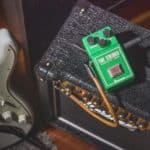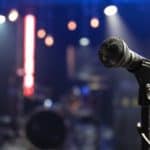One of the oldest effect pedals made, the wah pedal is a staple among guitar players everywhere.
Whether you dig the “Shaft” waca-chica, to those vocal-esque solo lines from “Enter Sandman” or “Surfing with the Alien”, you can thank the wah pedal for that.
When paired with an overdrive, the wah pedal’s placement on the board can drastically affect the overall sound. For those “vocal” sounds, it’s best to have it before. For a pronounced and sharp sweep, the overdrive should come first. Where it sounds best is based on the player’s preference.
So let’s take a deeper look at how the wah pedal’s placement takes your tone to different places.
Does pedal order really matter in a pedalboard?
While it may seem strange to beginners, or players new to using different or more effects for the first time, the order pedals are placed greatly impacts how they interact with each other, affecting your overall sound.
For instance, putting overdrive before delay will result in a spacious lead sound (à la Vai, Satriani, Petrucci, you get the picture).
Switching them would have every repeated signal be affected by the overdrive, compressing them and resulting in a stew distortion (see Steven Wilson’s rig, he loves this kind of overdriven cacophony).
The approach should be what you want to do. Do you want to distort the wah sound, or do you want the wah to affect the distortion? Once you’re able to answer that type of question, placement becomes more apparent.
Reasons to put your wah pedal before overdrive
A wah pedal, at its essence, is a giant tone control knob in a rocker pedal. It is similar to the tone control on your guitar, albeit with a much wider range.
It acts like a giant filter, boosting certain frequencies while cutting others depending on the position of the rocker pedal.
This kind of use plays very well when placed before your overdrive, allowing the overdrive to react to the tone coming out of the wah pedal.
This produces the vocal-like quality that we think of when we hear the word “wah pedal”.
The frequency variations hitting the overdrive are emphasized, adding harmonics and sustain to your playing. This is what gives the “vocal” quality to guitar solos that we associate with the effect.
Reasons to put your wah pedal after overdrive
Putting a wah pedal after your overdrive yields a very different beast.
When placed this way, you will hear a more pronounced version of the sweep of the wah, though the overall frequency range of your overdriven sound is radically altered depending on where the wah is set.
Because it is a tone control, you will notice that in the heal-down position, the loss of highs is apparent, as well as the opposite in the toe-down position (lows are gone).
This could be desirable for some people who want more of the sweep to come through.
The trade-off is that you also lose the vocal quality that the wah pedal provides when placed before any overdrive, losing the interaction the overdrive has with the tonal variation.
What is the most common order?
The “traditional” way to place these pedals harken back to days when a guitar’s overdriven sound was primarily due to amps being turned up loud.
This would have meant that the wah pedal would have gone before the overdrive in the grand scheme of things.
Jimi Hendrix, Slash, and Kirk Hammett, among many, will place the wah pedal before any distortion or overdrive (in either amp or pedal form).
Some players do have their way after their overdrive sources.
The main example would be Tom Morello, who runs his pedalboard (which includes his wah pedal) through the effects loop of his amp, placing the wah after the overdrive in the amp. This results in his distinct sound when using the wah pedal (à la “Bulls on Parade”).
Wah and overdrives, in most cases, should go before everything else
There is what can be considered the “traditional” signal chain where the guitar goes to the wah pedals and fuzzes, compression, distortion/overdrives/boosts, modulation effects (your choruses/phasers/flangers/etc.), then your time-based effects (delays and reverbs).
Wah pedals are also among a few pedals (including fuzzes) that need to see the guitar first (or as close to first as possible), otherwise, the sound could be affected by other pedals’ circuits, buffers, etc.
Usually, for “best” results, place the wah as close to the guitar as possible, and before your overdrives to take advantage of that vocal-like sound, and harmonic-processing voodoo that overdrive does to that wah’d signal.
However, one should always experiment to see what their preferred placement is. Try both and see if you dig one over the other. Neither are technically wrong; let your ears do the talking.

Hello there, my name is Ramiro and I’ve been playing guitar for almost 20 years. I’m obsessed with everything gear-related and I thought it might be worth sharing it. From guitars, pedals, amps, and synths to studio gear and production tips, I hope you find what I post here useful, and I’ll try my best to keep it entertaining also.





